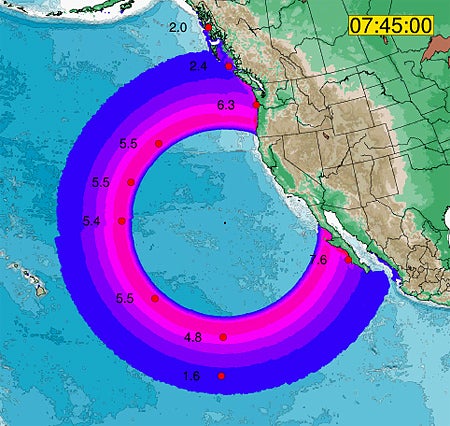Asteroid 2004 MN4 is back in the news again. Rusty Schweickart, lunar module pilot of Apollo 9, last week called on Congress to send a spacecraft to the asteroid and tag it with a transponder. Data transmitted by such a device would enable astronomers to determine whether or not 2004 MN4 will hit its target in 2029.
To those who follow space news, 2004 MN4 is hard to forget. Around last Christmas, astronomers ranked this asteroid’s chances of striking Earth April 13, 2029, at 1 in 37, giving it an unprecedented threat level of 4 on the Torino impact-risk scale. By the end of January, additional observations reduced the risk to 1 in 10,000, ruling out a 2029 impact — but not a future strike.
The new orbit held a surprise. It moved the location of MN4’s close 2029 pass outside the error box, the volume of space containing the probable positions computed by previous determinations. This isn’t supposed to happen. Clark Chapman, a prominent Near-Earth object (NEO) researcher at the Southwest Research Institute in Boulder, Colorado, found this occurrence so disturbing he suggested that alternate mathematical approaches might be better suited to characterize NEO impact risks than what astronomers are currently doing. Such techniques are used to evaluate risks of airline accidents or nuclear power plant disasters.
If 2004 MN4 passes through the keyhole, Earth’s gravity could deflect it just enough for an impact in April 2036. The keyhole’s existence is why the impact risk hasn’t dropped to zero. Optical and even radar observations aren’t sufficient to nail down the asteroid’s location to within 600 yards — only about 1.7 times the asteroid’s diameter. Achieving “adequate accuracy” is why Rusty Schweickart is urging we intercept MN4 and place a transponder and some scientific instruments on its surface, before 2014. Why so early? Astronomers need time to collect the precision data that will determine whether MN4 will pass through the keyhole.
If it will, lead time is essential in developing a mission to drive the asteroid from an Earth-impact course. Deflecting MN4 will be much easier before it encounters the keyhole in 2029. Efforts can focus on making the rock miss the keyhole rather than Earth. A change to MN4’s speed of about 0.1 inch (0.3 centimeter) per hour may be enough to eliminate its keyhole encounter. Even a modest rocket engine mounted on the rock’s surface could do the job.
Use of only optical and radar observations could result in an uncertainty in the asteroid’s position of some 37 miles by 2014, far too big to determine whether or not it will pass through the keyhole. The transponder will enable us to determine, with certainty, if MN4 will miss, which is the most likely scenario by far. For this troublesome asteroid — which has a striking power of nearly 1,000 megatons of TNT — the cost of tagging it may be peace of mind’s price.










